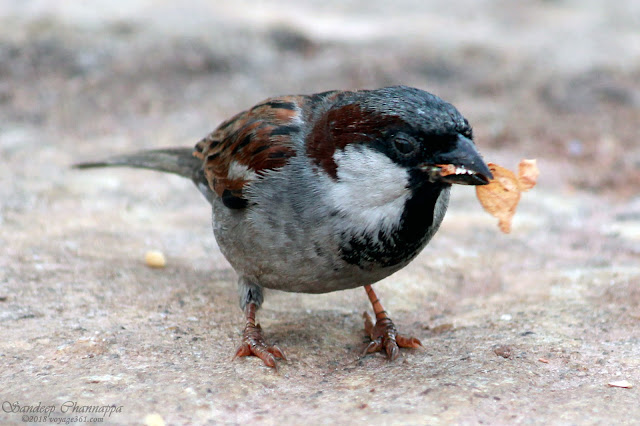Birding in Hesaraghatta Lake, Bengaluru
 |
| Black-winged Stilts at the Hesaraghatta Lake bed |
Having heard about the Hesaraghatta Lake for its abundant avian species, had planned my visit over the weekend.
About the lake:
Hesaraghatta Lake is actually a man-made reservoir built across the Arkavathy river in 1894. It served as a drinking water supply for Bengaluru city. The lake stretches over 3km long and nearly 1km wide during monsoons and the lake surface area covers upto 1,100 acres at its full capacity. The lake bed is surrounded by the grasslands which attracts raptors, shrikes and many resident bird species, and the lake itself attracts the water birds. Hesaraghatta used to be very popular among the birders when the Vultures and Eagles were commonly sighted. But today due to constant deterioration of the lake and increasing human intervention, the avian species count have drastically decreased.
Birds of Hesaraghatta Lake:
Hesaraghatta Lake has reported more than 240 species of birds till date, and is the second best bird hotspot in Bengaluru after Valley school (in terms of number of species recorded).
The list of birds goes long, some of the popular bird spotting at Hesaraghatta Lake are the Indian Peafowl, Gray Francolin, Laughing Dove, Greater Coucal, Asian Koel, Common Hawk-Cuckoo, Black-winged Stilt, Spotted Owlet, Eurasian Hoopoe, Indian Roller, Coppersmith Barbet, Ashy-crowned Sparrow-Lark, Jerdon's Bushlark, Oriental Skylark, White-browed Bulbul, Baya Weaver, Scaly-breasted Munia, Pied Bushchat, Indian Silverbill, Blue-faced Malkoha, Pied Cuckoo, Indian Golden Oriole and Rufous Treepie
The commonly spotted shrikes include the Brown Shrike, Bay-backed Shrike and Long-tailed Shrike. The migratory birds which visit the lake every year include the Little Ringed Plover, Common Sandpiper, Green Sandpiper, Wood Sandpiper, Black-headed Ibis, Rosy Starling and Siberian Stonechat.
Common sightings of raptors include Oriental Honey-buzzard, White-eyed Buzzard, Eurasian Marsh-Harrier, Tawny Eagle, Booted Eagle, Black-winged Kite, Short-toed Snake-Eagle, Eurasian Marsh-Harrier, Shikra and Eurasian Kestrel.
There have been reports of endangered species (under IUCN Red List) spotted here including the Egyptian Vulture and Steppe eagle and vulnerable species Indian Spotted Eagle, Greater Spotted Eagle, Pallid Harrier and Woolly-necked Stork.
Birding experience:
It was the beginning of the migratory season, reached the lake parking by 8.30 a.m. Started my bird walk along the lake bund followed by the grasslands. To begin with, there was a group of House sparrows near the temple, which have become a rare spotting in Bengaluru city. This was the first time I spotted sparrows in Bengaluru. Further down there was a small flock of Scaly-breasted Munia's.
 |
| A male House Sparrow - They have become a rare sight in Bengaluru city |
 |
| Scaly-breasted Munia |
River terns were seen hovering around the lake in search of their prey. A group of Black-winged Stilt were seen at the edge of the lake along with the Gray Herons, Cormorants, Egrets and a lone Glossy Ibis. Eurasian Coot's were seen all across the lake.
 |
| The long legged Black-winged Stilt |
Continued my walk at the grasslands surrounding the lake bed. Although I couldn't spot the eagles, but was happy to have spotted Shikra, Bay-backed Shrike (lifer) and Long-tailed Shrike. Indian Silverbills were busy collecting materials for building their nest. On my way back spotted Baya weaver and Paddyfield Pipit.
 |
| Bay-backed Shrike |
 |
| Paddyfield Pipit foraging on the beautiful landscapes of Hesaraghatta lake grasslands |
 |
| Silverbills were spotted with a lovely backdrop of the lake |
The whole area was mostly secluded and felt unsafe for solo visitors. The lake bed is also made restricted by the BWSSB authority, but human activity was still seen common, animal grazing, fishing and young couples seen busy with their activity at the lake bed.
Apart from the bird watching, the lake itself is worth the visit due to the beautiful landscapes it has to offer.
 |
| Hesaraghatta Lake |
Complete checklist of birds at eBird:
https://ebird.org/india/view/checklist/S48859830








Comments
Post a Comment